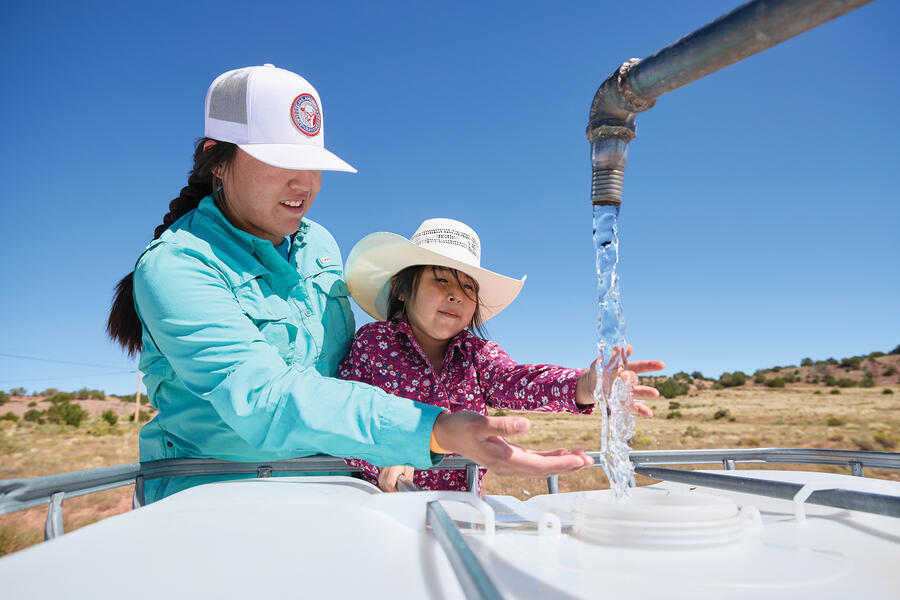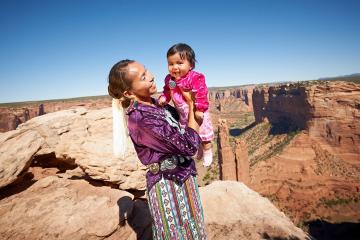Travelers in the vicinity of Navajo Nation, the largest tribal nation in the U.S., may notice an unusual feature of many vehicles: large-volume water tanks, filling the entirety of a truck bed, headed to homesteads far and wide. "Water hauling," as it is known, is a long-standing practice born out of necessity for many residents of Diné Bikéyah who either do not have piped water or need to supplement their supply for both the people and livestock in their care.
The ubiquity of water hauling raises a basic question: How many households on Navajo Nation do not have piped water? Until recently, the answers were speculative; estimates ranged anywhere from 15% to 40% of households and lacked the specificity needed to assess the contributing factors and related health concerns.
Enter the Johns Hopkins Center for Indigenous Health's Diné Household Water Work team, which has, for the past four years, systematically collected missing water access data and, in the process, gathered powerful testimony from community members.
"What I've come to learn through this study is that tribal communities [focus] on their resilience and cultural strengths rather than deficits," says Ashley Thacker, a Diné tribal member and community principal investigator for the study. "Those are the stories we're hearing repeated by a group of people who have learned generation upon generation how to adapt and work with neighbors, with relatives, and with partners to ensure their households have adequate water."
The importance of water access for health, Thacker says, had been evident in the center's long-standing work on childhood obesity prevention, but it was COVID-19 that highlighted the urgency. That's when the center leveraged partnerships plus funding from the Osprey Foundation and private donors to conduct a pilot survey of water access and quality in the Fort Defiance Agency, the largest of Navajo Nation's five agencies.
Thacker and project manager Reese Cuddy knew that a full door-to-door household census was not logistically possible, given the vast expanses, largely unpaved roads, and informal home addresses. Spanning parts of Arizona and New Mexico, Fort Defiance Agency has a population of over 42,000 residents and comprises 27 chapters or local governance units.
Using Google Earth Pro and publicly available satellite data, the research team randomly selected households to ensure a representative sample of the full agency. In the summer of 2022, a group of interns and local Hopkins team members embarked on the herculean effort of verifying satellite data and physically reaching hundreds of selected households with the survey and water test kits.
"Our team sat down with chapter officials and community members to look at the map frame by frame, confirming every household," Cuddy recalls. "Our surveyors drove over 200,000 miles down these bumpy dirt roads, including evenings and weekends, to make sure that we're giving residents the best possible opportunity to participate."
"The core of this work is sitting down with community members and listening to their stories," says Thacker, who was involved in training the surveyors as well as conducting interviews. "It is such an honor to hold that space. … Bearing witness to these life experiences connects me deeply to my community."
Nearly 1,000 surveys later, the DHWW team found that an estimated 27% of homes in Fort Defiance Agency do not have piped water to their homes. Bottled water is widely used for drinking by more than 72% of households, regardless of whether the homes have piped water access. And water hauling is practiced by 41% of Navajo households, with the largest burden falling on residents over age 55.
Also see
"These findings provide us with a huge set of clues about where future work can be done, and ways to inform policy that will remove barriers to water access," Cuddy says. "We're starting to understand, for example, distrust toward the tribally run piped water system, which, despite meeting safe drinking standards, may look or taste unappealing. We've uncovered bureaucratic reasons some homes are not connected to water networks. There is a wide range of solutions, some of which are well within reach."
As the DHWW team aspires to replicate the survey across Navajo Nation and leverage the results in policy discussions, survey participants are front of mind.
"I hear the echo of their voices in the data we're producing—the Indigenous experience is driving the Western research," Thacker says. "Every aspect we're trying to do mindfully, even in terms of disseminating the results to participating communities, by reflecting back their stories along with the big picture of what we're learning."
Posted in Health
Tagged public health, community, clean water, water scarcity, safe drinking water act, center for indigenous health









